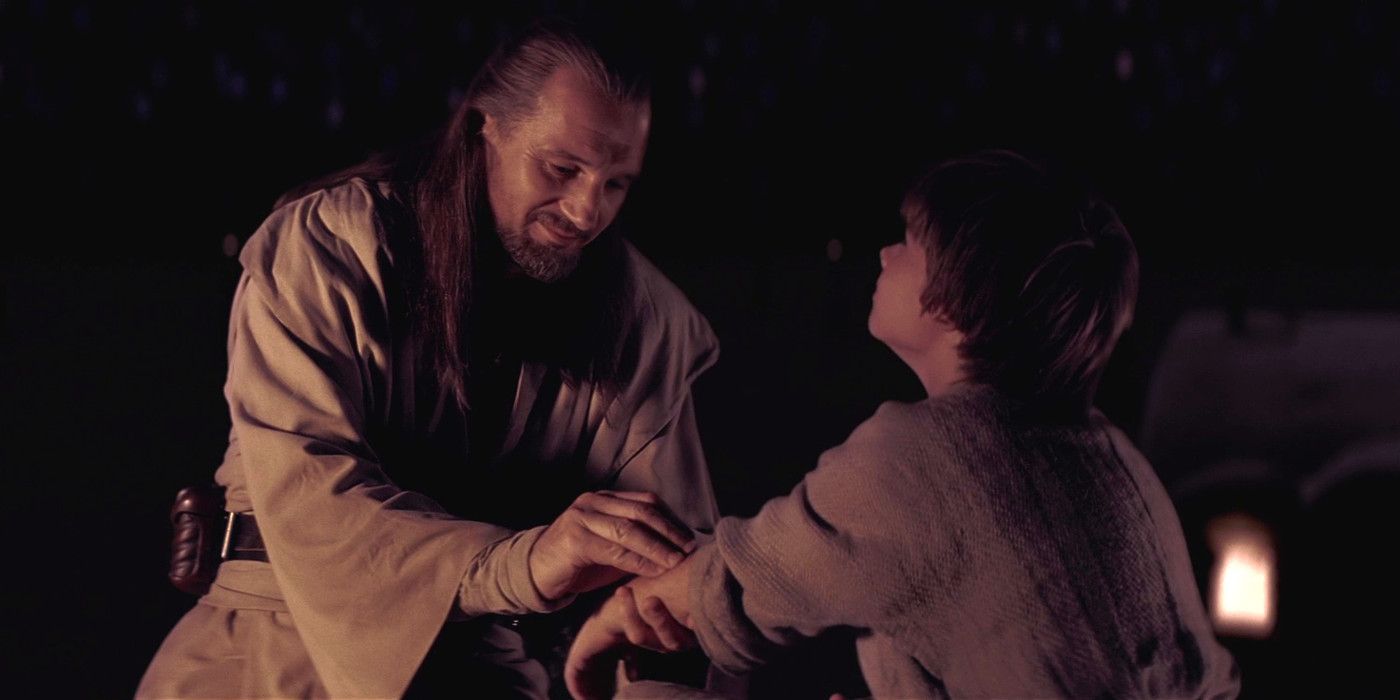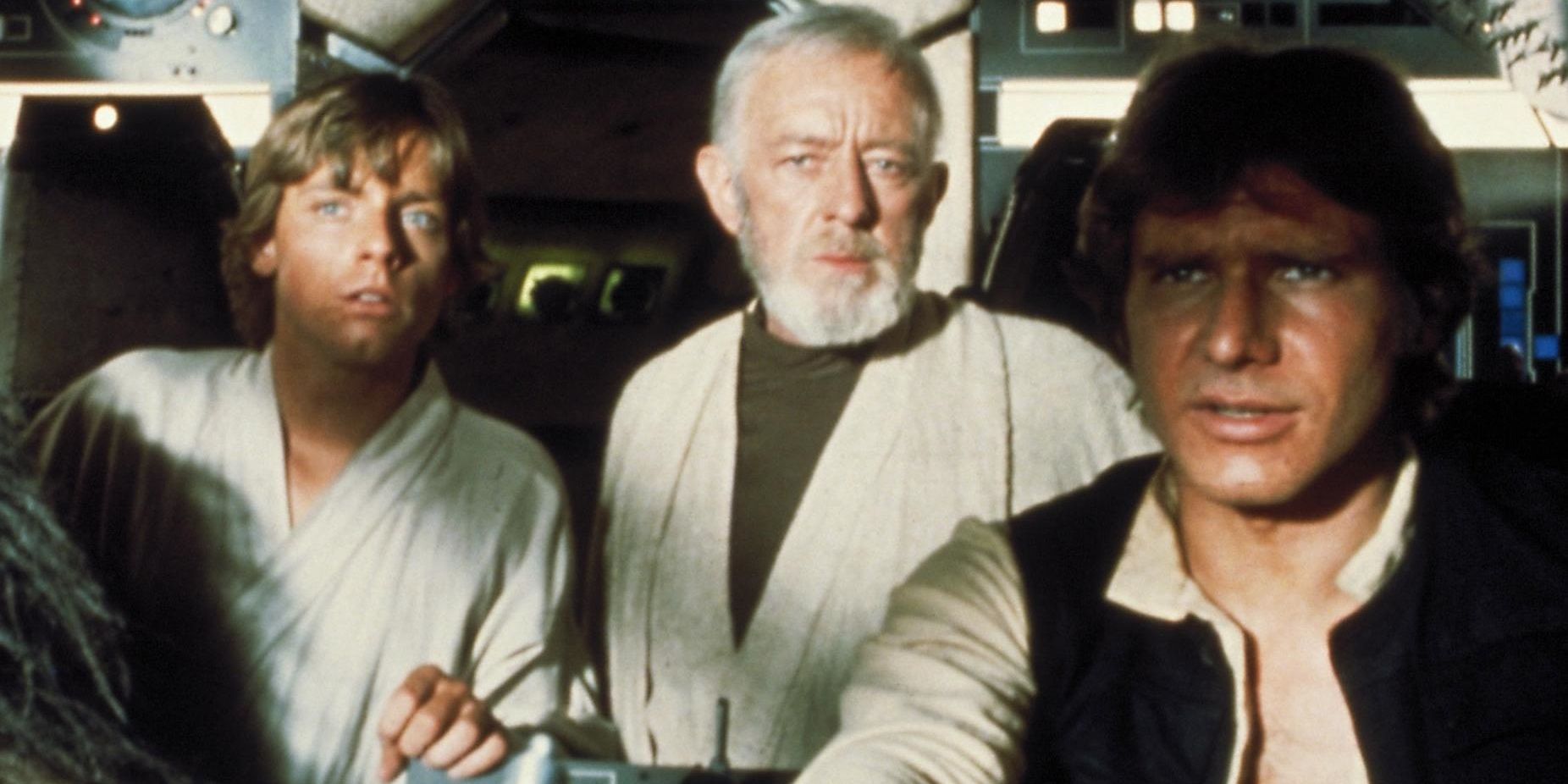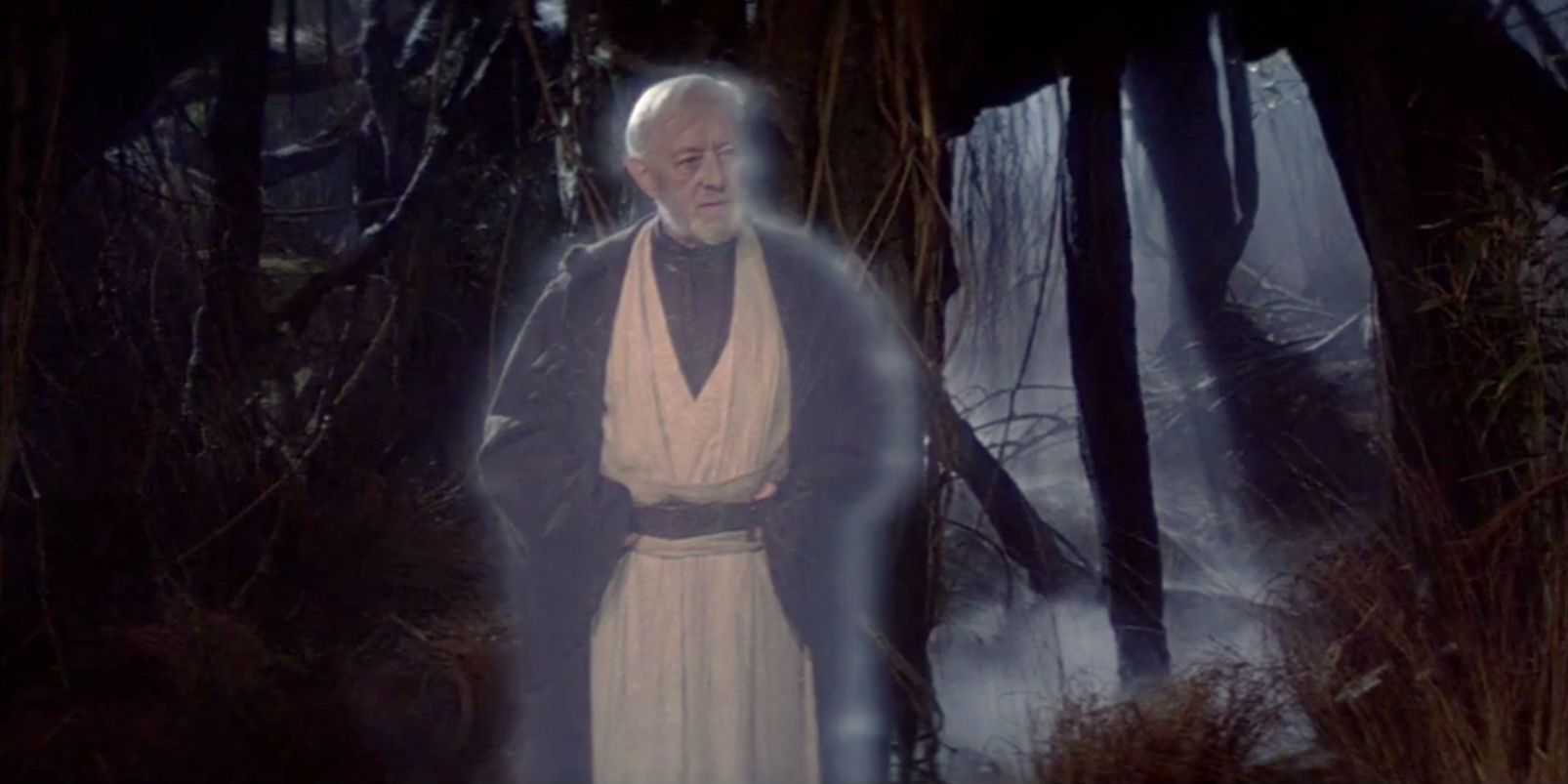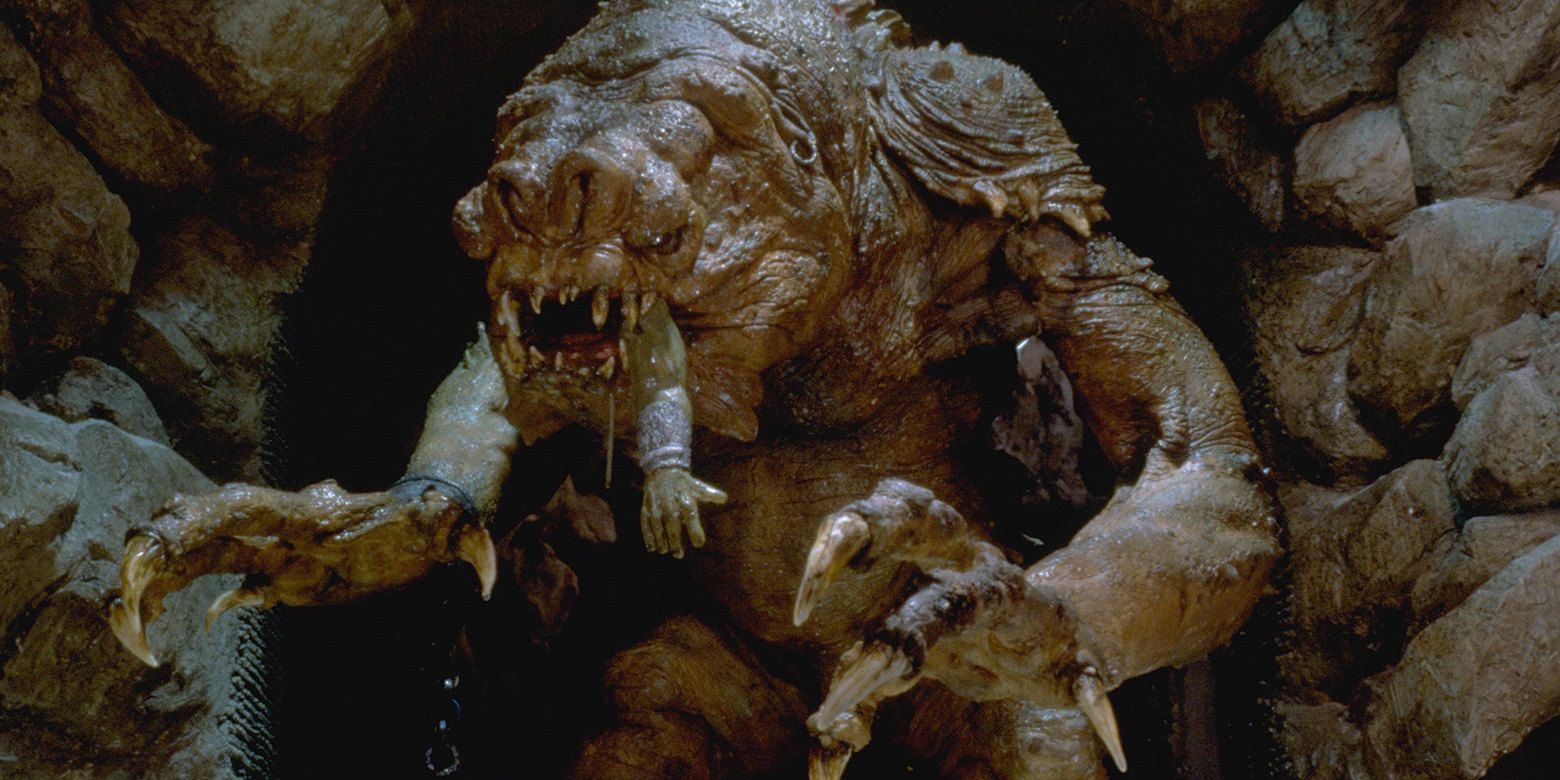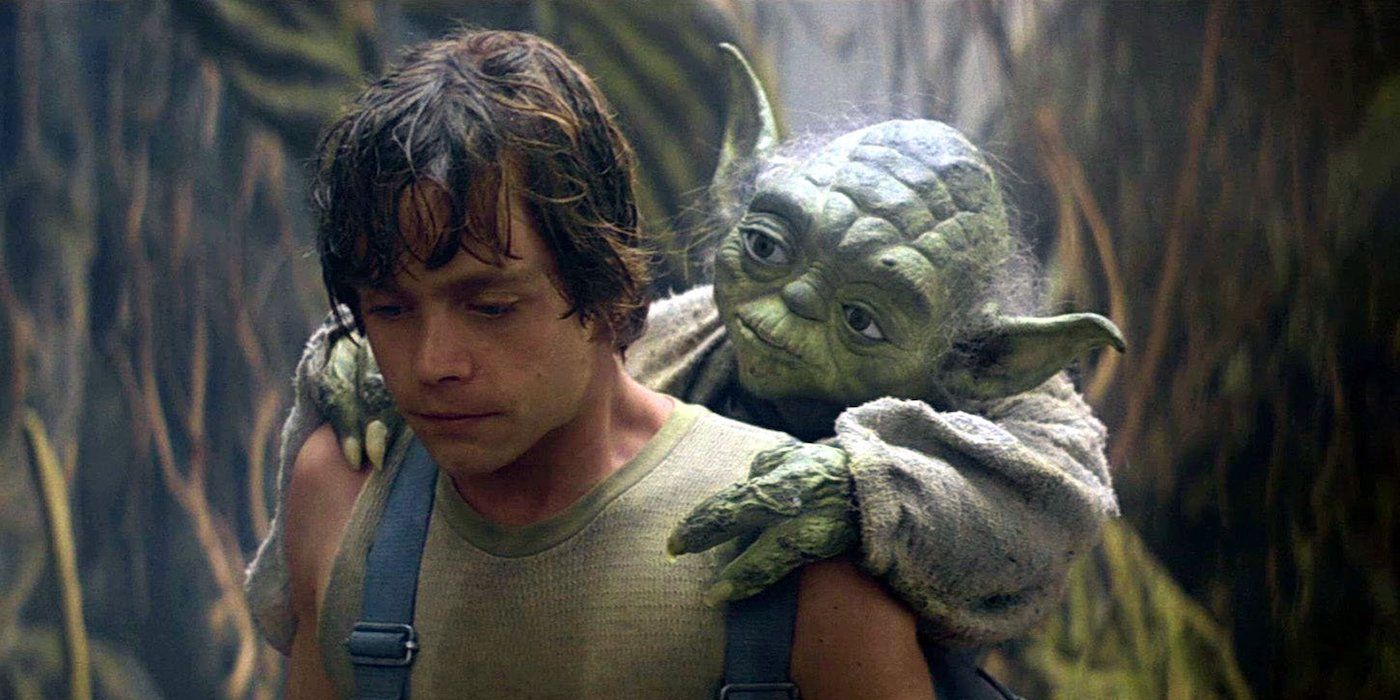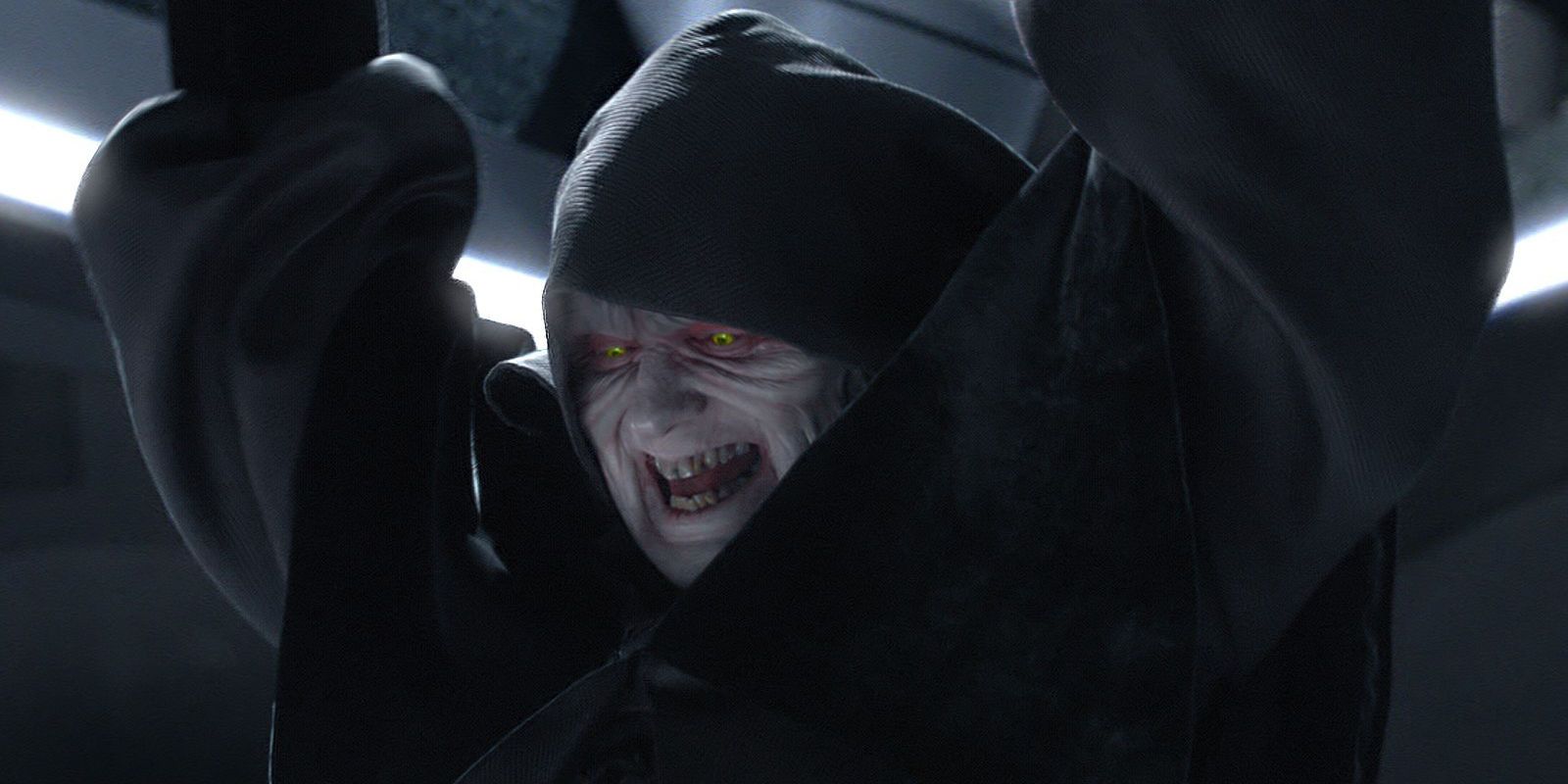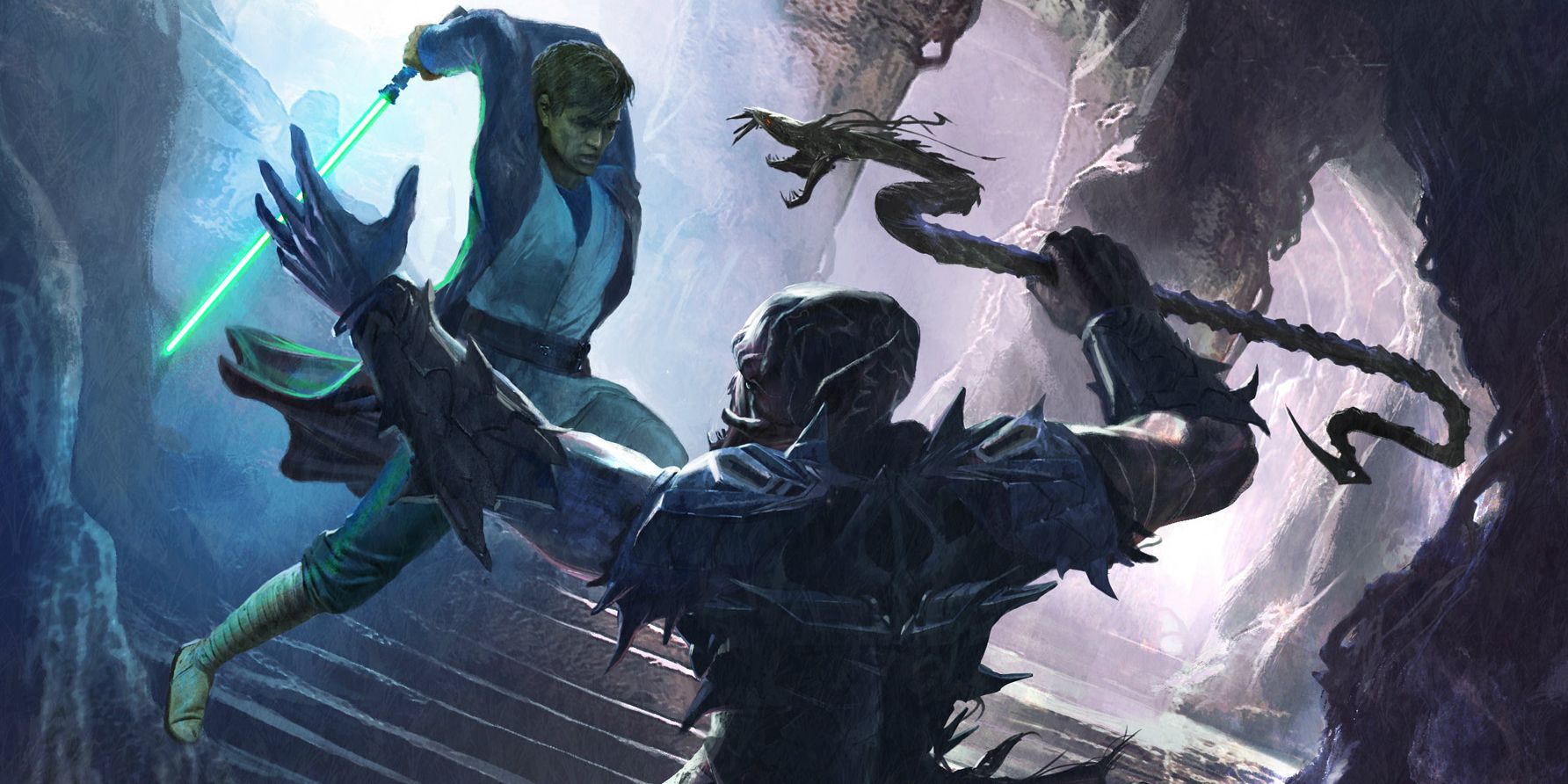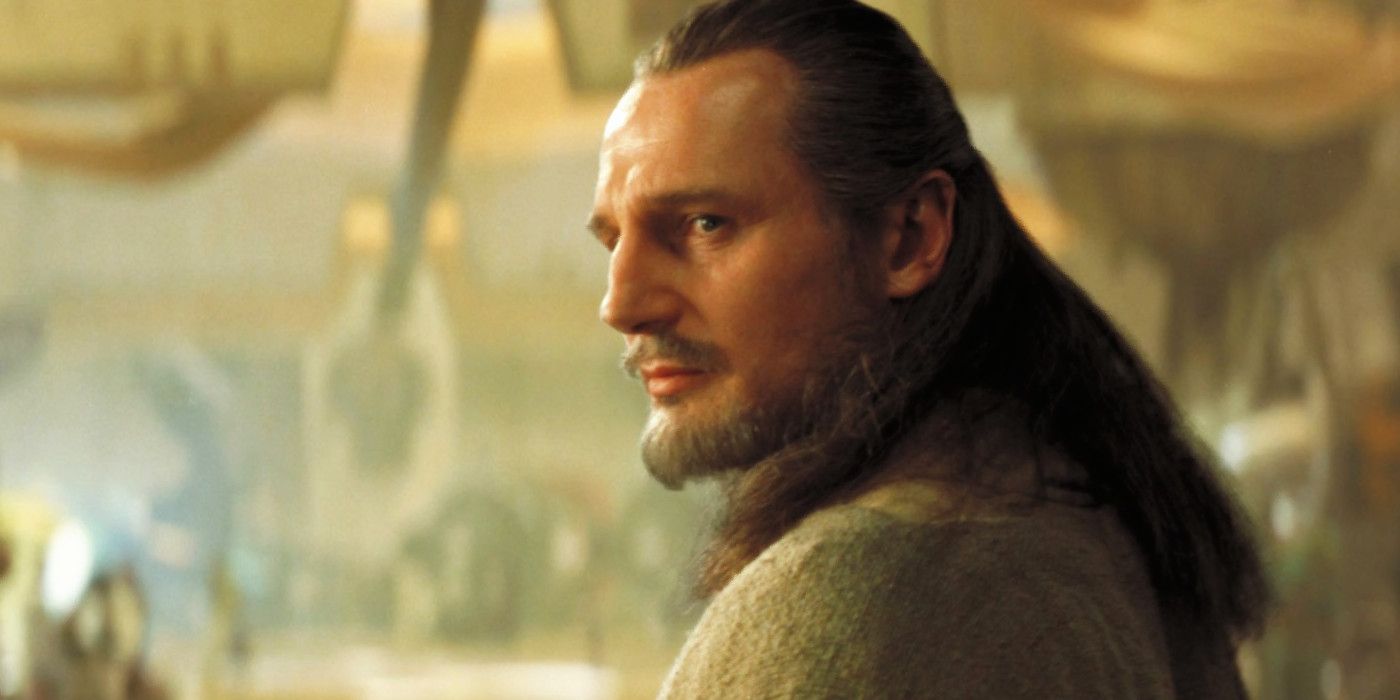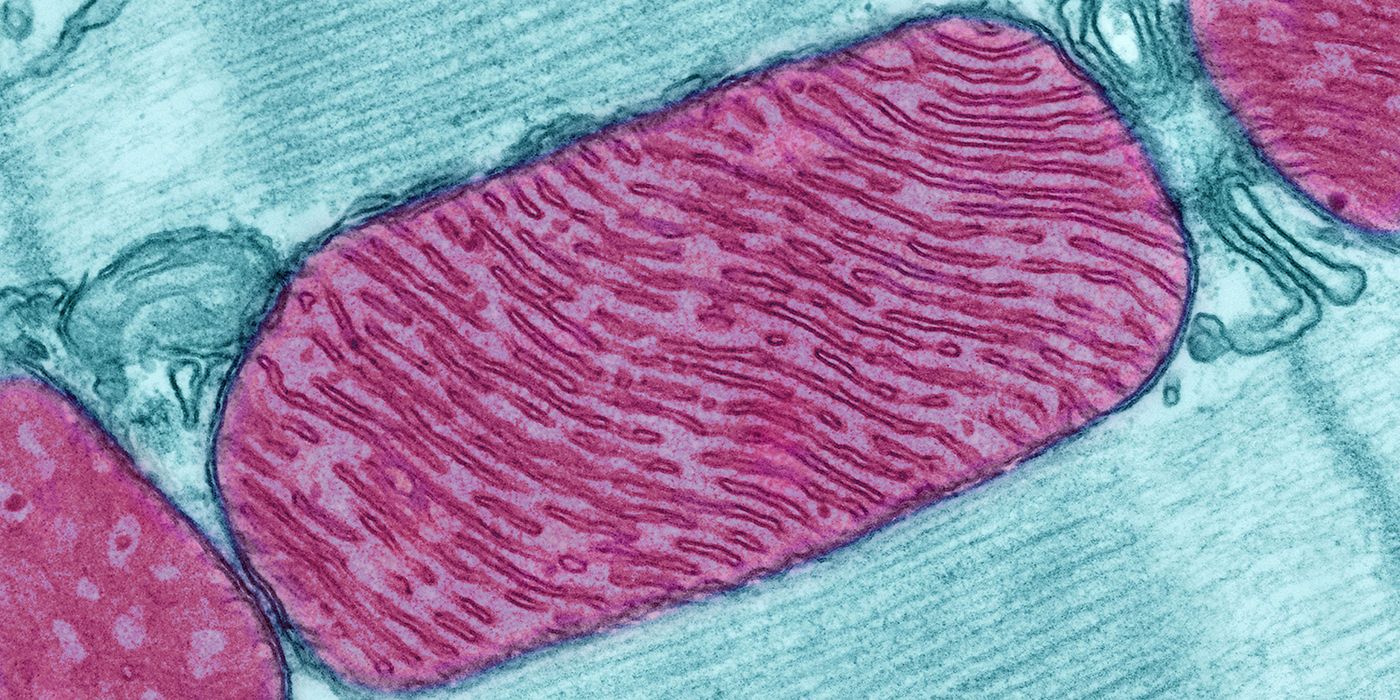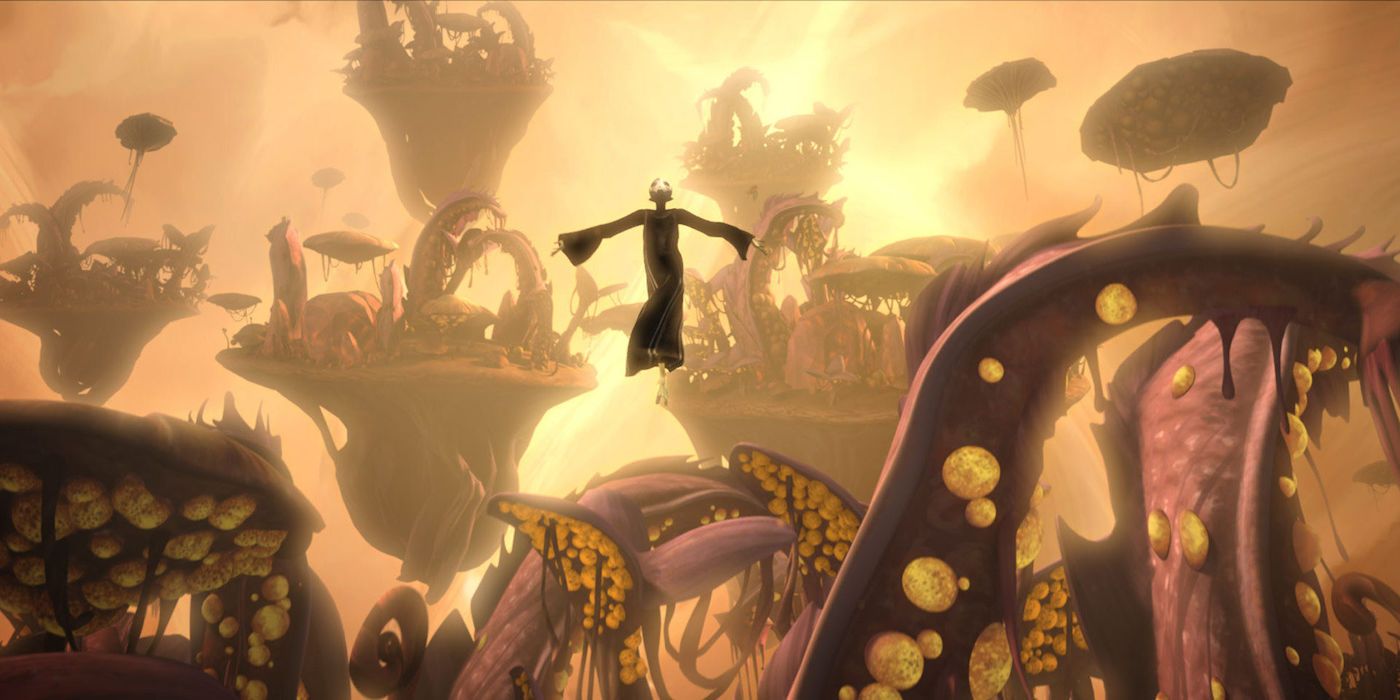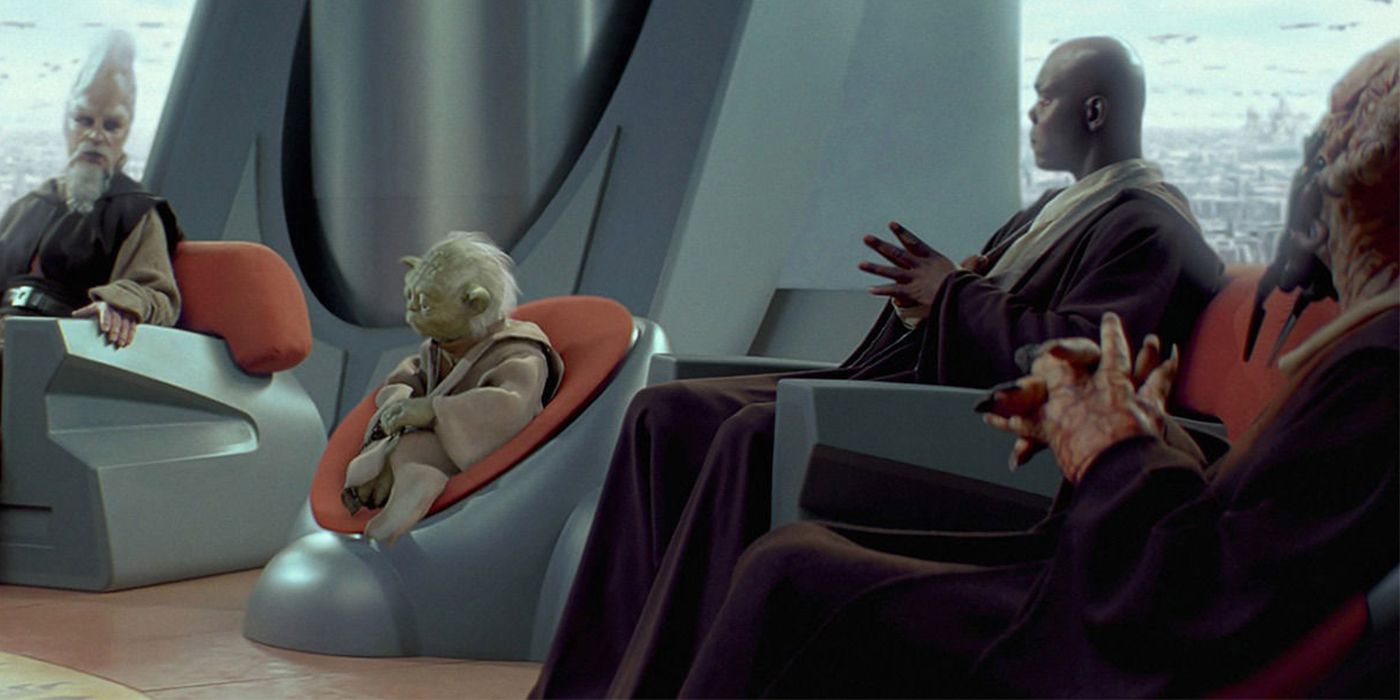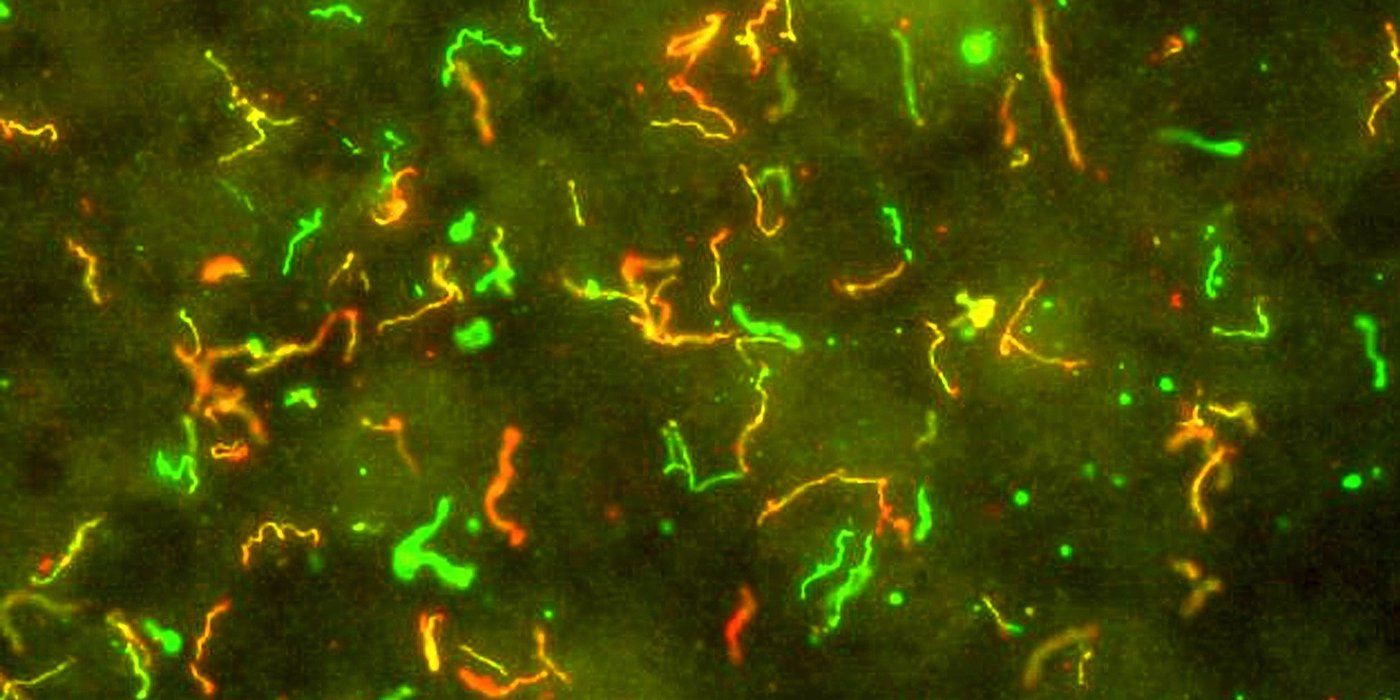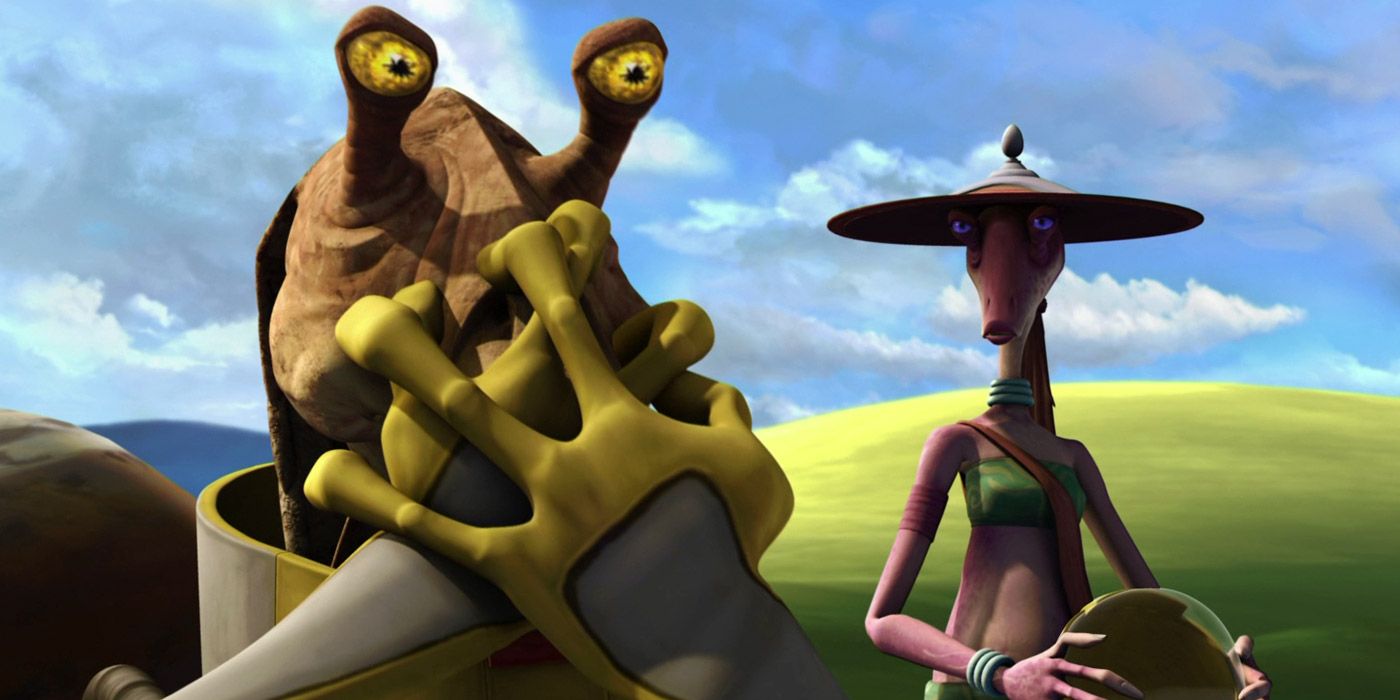Along with "comic" character Jar Jar Binks, midi-chlorians were the most controversial addition to Star Wars lore when The Phantom Menace premiered in 1999. Almost 18 years later, fans and creators are still trying to figure out what to do with these microscopic beings, which Menace reveals -- in one of the most obvious exposition scenes we've ever witnessed -- that they live in our cells and tell us a little more about the Force.
Trade embargoes aside, midi-chlorians are why the entire prequel trilogy happens, because young Anakin Skywalker is just full-up with the chatty little suckers. His crazy density of symbiotes makes Qui-Gon Jinn sure that he is the "Chosen One" spoken of in flimsily explained prophecies. This drives him to train the boy up as a Jedi, despite the fact that the smartest and wisest Force users in the galaxy take one look at him and go, "That kid's crazy."
But whether they ever come up again or not (The Force Awakens director J.J. Abrams intentionally avoided mentioning them in his film), midi-chlorians are canon, so we might as well try to understand them. Here are 15 things you probably never knew about midi-chlorians -- possibly because you think they're dumb and hate that they exist, which is a position we both understand and respect.
15. Without midi-chlorians, life could not exist
Unless your brain immediately deleted the terrible dialogue from that explanation scene, you remember that Qui-Gon tells Anakin literally this: midi-chlorians make life possible. But how? And why does this matter?
We'll cover some science a little more later, but the big picture is that, like it or not, midi-chlorians provide a non-mystical, measurable way to back up most Jedi teachings. So when Obi-Wan says that the Force "ties all living things together," he can point to the midi-chlorians as evidence, since they're omnipresent.
This actually makes the scene in A New Hope -- in which Han Solo laughs off the mumbo jumbo and extols the virtue of blasters -- slightly more interesting, considering Kenobi could have just pulled out an analysis set from his unseen Travel Jedi Kit and proven Solo wrong. But he doesn't to that, either because he's more mature than we are or, more likely, because who really cares. We just wanted to get on with those Star Wars.
Midi-haters say that the Force doesn't need to be quantifiable; it's all about feelings, instincts, and magic, man, and they're way too sci-fi an element for a series that had always been more about fantasy and adventure. But like it or not, those Jedi superpowers have to come from somewhere, and blood bugs are as good an explanation as any.
14. They link the Living Force with the Cosmic Force
When Jedi talk about "the Force," they actually mean two things. One is the physical or "living" Force, which is that energy field that all living things put out. But a more universal, cosmic Force also exists, and we think that's what Yoda is talking about in The Empire Strikes Back when he's telling Luke not to be such a quitter about fishing his X-Wing out of the swamp.
"[M]y ally is the Force, and a powerful ally it is," he says. "Life creates it, makes it grow. Its energy surrounds us and binds us. Luminous beings are we, not this crude matter. You must feel the Force around you; here, between you, me, the tree, the rock, everywhere, yes. Even between the land and the ship."
As non-living objects, things like rocks and ships don't put out their own energy fields, so Yoda is talking about a different phenomenon altogether. It's a very slight distinction, but you can think of the Living Force as a battery and the Cosmic Force as the machine it powers. It's a machine that controls (for lack of a better phrase) destiny and contains all knowledge of the universe. And that's where midi-chlorians come in.
Our microscopic passengers are in touch with the Cosmic Force, and they communicate its will to those who are focused enough to hear it. They are more or less the "voice" of the Force, and that's where all that mind-clearing and concentration comes in during Jedi exercises. By quieting your own errant thoughts, Jedi can hear the midi-chlorians talking to you, and this gives you knowledge of what the universe "wants."
13. They're sentient and intelligent
The midi-chlorians' ability to communicate the will of the Cosmic Force suggests a certain amount of intelligence. They aren't just like the bacteria that live in your gut that help you digest food; they're constantly talking to their hosts and telling them what the universe wants from them. And some people listen a little better than others.
We're talking about the difference between Jedi and the Sith, who we assume both open their minds to their midi-chlorians but do different things with what they hear. And each camp can unlock powers and abilities that the other simply can't. Sith, for example, don't seem to listen to the midi-chlorians telling them that all life is connected and important, so they use their abilities to do things like Force Chokes and Force Lightning, which we'd assume is not what the CF wants, because their only purposes are harm and murder.
Jedi, on the other hand, can use their knowledge of both aspects of the Force (via midi-chlorians) to learn an ability that seems to be completely off-limits to Dark Side practitioners: becoming one of Yoda's "luminous beings" after death. We can't necessarily argue that midi-chlorians prefer Jedi to Sith any more than a light switch can prefer being installed in a kitchen over a secret torture dungeon, but over the long term, they definitely have more to offer the good guys.
12. Every living cell everywhere has at least one midi-chlorian
Qui-Gon mentions this in his initial explanation, but the interesting thing here isn't that midi-chlorians are there, but that they can be there in varying degrees. According to writer/director George Lucas, "In Anakin’s case, there are, instead of one or two or three midi-chlorians in each cell, there’s like a thousand. It’s unbelievable how many midi-chlorians are in there.”
Anakin's blood test in The Phantom Menace produces a reading of "over 20,000," which we assume is a lot because the characters say it is and look astonished when they do. We don't have a lot of context outside of that -- or any context, really, because we had literally just learned that midi-chlorians existed, and it was a lot to take in all at once.
What's interesting here, though, is that hey, grumpy skeptic Han Solo: you too have midi-chlorians in your cells, and they are talking to you even while you say they're bullshit. Lucas once said that everyone has midi-chlorians except the roguish smuggler ("He's a zombie," the director said), but we're pretty sure he was kiddin,g seeing as how Han was alive and all.
11. They are why Dagobah is so weird
Ostensibly, the swamp planet of Dagobah is strange because it's full of insane, droid-spitting animals and is home to a cave that will show you your worst fears. And if you had your choice, it would probably be second on your list of least pleasant places to hide out from a Jedi genocide. First, obviously, is Tatooine, because even people who choose to live there willingly don't seem super thrilled about it.
But Dagobah's weird, dense, snaky ecosystem actually makes it a solid tactical choice for Yoda's hiding place. All of that life means ridiculous numbers of midi-chlorians, and all of their constant chatter about the will of the Cosmic Force provides an effective smoke screen for a fugitive Jedi wanting to hide his presence from Darth Vader. But the animated series The Clone Wars provides even more reasons Yoda might want to go there.
The final-season episode "Voices" has Yoda making his first trip to Dagobah after he hears the voice of long-dead Qui-Gon Jinn telling him to go there. This is a secret mission, because the other Jedi think Yoda might be going crazy or under Sith attack, and a strong desire to go to the second-crappiest planet in the galaxy on the advice of a ghost probably wouldn't convince them otherwise.
Qui-Ghost tells Yoda about the Living and Cosmic Forces, and how the midi-chlorians work between them. This is news to Yoda, and we were surprised that Jedi had been protecting the peace of the Republic for a thousand generations without knowing the basics of their worldview. But that's a side issue.
The main thing is that the massive amount of life energy and midi-chlorian noise that the copious Dagobahan wildlife puts out make it a good site for communing with the Force and also makes sensitives immediately uncomfortable when they go there. Luke says as much when he gets there in Empire, just before Yoda arrives to steal his gear and hit his astromech with a stick.
10. Lucas wanted to introduce them in Episode IV
If all of our callbacks to A New Hope sound like we're hopelessly trying to justify a massive retcon, we're lucking out on this one, because Lucas had intended midi-chlorians to be part of Force lore all along. According to the behind-the-scenes book The Making of Star Wars: The Definitive Story Behind the Original Film, Lucas had set terms for midi-chlorians as early as 1977 while establishing the "rules" for Expanded Universe works.
"It is said that certain creatures are born with a higher awareness of the Force than humans," Lucas said. "Their brains are different; they have more midi-chlorians in their cells."
This is 20 years before the critters had their first mention in official Star Wars canon, but Lucas said that there hadn't been time or opportunity to get into it in the original trilogy. They had an Empire to fight, after all. And he's right, because that would have required bringing the entire plot to a halt and having an awkward and largely unnecessary exposition scene. You know, like the one in The Phantom Menace.
9. ... but the idea of higher concentrations granting greater potential is a prequel concept
Despite Lucas apparently having midi-chlorians in mind all along, it's not necessarily true that he had always envisioned making the actual number of the things in one's cells variable. All he said was that "certain creatures" have more than humans, which just means that people, like Luke Skywalker and Obi-Wan, are just less Force-sensitive than species like whatever the hell Yoda is. And we don't find that super controversial, considering that the Original Trilogy has always pretty clear that Yoda was crazy powerful in The Force.
But the clear statement that one person might have more midi-chlorians than another is what makes them so weird. Giving Anakin more midis than Yoda means that even within one's own species, Force prowess is just a complete crap shoot of genetics. It's like whether or not a person in the Marvel Comics universe is a mutant, and then whether their mutation is actually useful.
8. Their communication with the Force (and beings) can be blocked
The prequels contain some vague references to Dark Side influence "clouding" the Force, making it more difficult for the Jedi to commune with it and figure out what's really going on. That's the narrative reason for why Anakin and the Council can spend so much time in meetings with Chancellor Palpatine without their Sith Sense going off.
The Sith disrupt the natural order, because instead of just letting the Force doing its usual flowing and binding, they manipulate its energy to give themselves power. That lightning shooting out of their hands isn't cheap, you know. And those Darths sucking up all that Living Force means that the midi-chlorians don't have anywhere to impart their knowledge of the Cosmic Force, which is probably shouting things like, "Don't go to the Chancellor's office, you idiots! He has a lightsaber!" like an anxious person watching a horror movie.
The now-non-canon Yuuzhan Vong are another weird case. They're a marauding species that appears in the Legends books, and their invasion of the galaxy claims hundreds of trillions of lives and almost destroys the fledgling New Republic. Their military actions in their home galaxy destroyed their living planet, with which they had a symbiotic relationship. Somehow, this removed them from the Force, which sent them on a Hellraiser-style quest of transcendence through pain and horrifying body modification. It also meant that Jedi have trouble sensing or fighting them directly, because they just don't have a presence in the Living Force.
Since their stories came out before the proper introduction of midi-chlorians -- although Lucas' guidelines did specify that midi-chlorians existed -- nothing in those novels mentions what this separation means for the microscopic symbiotes. But the Force was still so much space magic back then, so nobody really worried about it. If we had to guess, though, we'd say that the midis just stopped speaking to the Yuuzhan Vong once the link with their planet broke.
7. Qui-Gon Jinn was obsessed with them
We've already talked about how Qui-Gon Jinn's implicit trust in midi-chlorians got pretty much all of his friends killed. But he was also a student of the Living Force -- apparently the only one, because his studies led him to unlock the secret of life after physical death, which totally blew Yoda and Obi-Wan's minds when they found out about it.
Most Jedi were happy just to listen to their blood buddies and try to do the right thing for the galaxy, but Qui-Gon dedicated himself to understanding the actual mechanics of the Force and midi-chlorians' relationship to it. This lead him on a quest to discover their source, which also revealed to him the Living and Cosmic aspects of the energy field. He made a lot of progress toward complete knowledge and figured out that it was not only possible to live after death, but that one could both learn and teach this ability.
Qui-Gon gets a pretty decent opportunity to test his new training when Sith apprentice Darth Maul murders him at the end of The Phantom Menace. And luckily it works, because he's able to speak to Yoda during the Clone Wars and send him on his own mission to complete Jinn's research.
6. They're (kind of) based on real things
If the word "midi-chlorian" sounds familiar, that's not a coincidence: Lucas based his Force Whisperers on the real-life cell residents mitochondria, which are involved in reproduction and death, energy generation, and cellular communication.
Unlike their fictional counterparts, mitochondria aren't omnipresent or evenly distributed. You don't have any in your red blood cells, for example, but your liver is just full-up with the things. But as far as we know, the things aren't talking to us, although it's possible we just can't hear them over all the Star Wars trivia and sitcom theme songs from the '80s we have clogging up our minds. As Lucas himself explained:
Midi-chlorians are a loose depiction of mitochondria, which are necessary components for cells to divide. They probably had something [. . .] to do with the beginnings of life and how one cell decided to become two cells with a little help from this other little creature who came in, without whom life couldn’t exist. And it’s really a way of saying we have hundreds of little creatures who live on us, and without them, we all would die. There wouldn’t be any life. They are necessary for us; we are necessary for them.
We don't know how that equates to superpowers or hearing the secrets of the universe, but we're still basically dealing with science-fantasy here, and we won't begrudge the man his metaphor.
5. They have a home planet
Part of Qui-Gon's studies were about discovering where midi-chlorians came from in the first place, and he actually made some progress in pinning it down. After he returned from the Force to guide Yoda to Dagobah, Jinn says that the living Jedi should seek out another planet that may be the source of all life in the galaxy.
In the Clone Wars episode "Destiny," Yoda discovers this energy-spewing world deep inside a nebula. There, he meets five Force Priestesses, who set him on a series of tests to prove his dedication to true selflessness and immersion in the Light Side of the Force. It's an interesting series of episodes with a lot of reveals, not the least of which being that the midi-chlorians that create and perpetuate all life and allow practitioners to hear the will of the cosmos have a clear and definite source.
Yoda faces trials both on the midi-chlorian homeworld and the Moraband (also known as Korriban), the birthplace of the Sith. Once he overcomes them, he has all the Force knowledge he needs to become one with the universe upon death. And he also tells Obi-Wan how to do this, because unlike their enemies, Jedi actually share knowledge.
4. They stagnated the Jedi Order
We aren't blaming the midi-chlorians directly for causing the fall of the Jedi Order, because only a poor crafter blames their tools. But we can argue that the group's reliance on midi counts set their demise into motion.
It starts with poor, foolish Qui-Gon Jinn, whose amazement at young Anakin Skywalker's staggering concentration of midis made him insist on training the boy. To their credit, the Jedi Council actually checked the kid out before they agreed and discovered the anger and fear that actor Jake Lloyd just never managed to convey. But none of the actors seemed super into anything they were doing in those movies, so we're thinking the issue might have been the direction.
All of that aside, Jinn's belief that Anakin's over-20,000 midi-chlorian count marked him as the "Chosen One" of Jedi prophecy, and his faith was so pure that he made it his dying wish to ask Obi-Wan to train Skywalker regardless of what the Council said. And because the Jedi Council apparently has a "dying wish" clause that lets requests supersede all of their previous decisions provided the petitioner is about to croak, they ago ahead and sign off on it. And we see how that turned out.
This is all because of the entrenched Jedi belief that higher midi-chlorian counts make more powerful Jedi, but we don't think that's true because ...
3. They measure potential, not power
Due to their nature as conduits and spokesthings of the Cosmic Force, midi-chlorians alone don't determine actual prowess. All a massive concentration should do is make it easier for you to listen, but what you actually end up doing with the knowledge they give you is still up to your particular skill and character.
George Lucas describes it this (weird) way in a conversation he had with screenwriter Lawrence Kasdan and director Richard Marquand, before Return of the Jedi shot:
Kasdan: The Force was available to anyone who could hook into it?
Lucas: Yes, everybody can do it.
Kasdan: Not just the Jedi?
Lucas: It’s just the Jedi who take the time to do it.
Marquand: They use it as a technique.
Lucas: Like Yoga. If you want to take the time to do it, you can do it; but the ones that really want to do it are the ones who are into that kind of thing. Also like karate.
What this tells us is that all the midi-chlorians in the galaxy won't make you all-powerful if you're crap at being a Jedi. And we see this play out, even in the prequels. When he gets older, Anakin lets fear dominate his actions after he has nightmares of his wife dying. This leads to his fall to the Dark Side and, of course, Padmé's death.
A more wise Jedi might have taken those dreams as warnings not to give in to his fear, and not the prophecies they became in retrospect. Barring that, he might have just told someone who wasn't a secret Sith Lord about his problems. It's easy for us sitting on the outside to question Anakin's actions and decisions, but we don't feel too bad about it because they were basically always wrong.
Unfortunately for him (and basically the entire galaxy), Anakin's first experience with the Force was finding out that he contained more of the things that make its manipulation possible than anyone else in history, and this made him a big deal. And he never stops believing that, even when he sees an unwinnable situation at the end of his climactic fight with Obi-Wan at the end of Revenge of the Sith.
Despite Obi-Wan's warnings, Anakin believes that his power potential makes him unbeatable. And that's the last mistake he makes while still owning all of his original limbs.
2. They're real. Sort of
We aren't talking about mitochondria again, although those are definitely real. Instead, we mean the real-life bacterium Midichloria mitochondrii, a species that science named in a study in 2006.
Nate Lo, a researcher who was working at the University of Milan, discovered Midichloria while studying deer ticks and Lyme Disease. While doing so, he and his team found the new bacterium living inside the mitochondria of a specimen's ovaries, which is extra weird because mitochondria are very similar to bacteria, themselves.
Unlike their namesakes, Midichloria are neither responsible for nor particularly encouraging of life. They actually get in between the inner and outer membranes of the mitochondria they infect and eat their host up. None of this seems to hurt the ticks, however, and none of them have developed any kind of telekinesis or psychic ability. So far.
Lo named his find after Star Wars' midi-chlorians despite never having seen the prequels, and on the advice of one of his co-authors, he sought Lucas' permission to avoid possible legal trouble. The scientists received the go-ahead, and the paper published later that year.
"One reviewer was very negative about the name, but fortunately the editor was fairly open-minded," Lo said. And that's probably the best reception midi-chlorians of any kind have ever received.
1. They don't 'ruin' the Force
Fans have generally not taken this aspect of the Force kindly since Lucas introduced it almost 20 years ago. We get it; midi-chlorians add a quantifiable, hard-scientific element to a phenomenon that had always just been mystical, spiritual, and vague. And the line, "I've been wondering, what are midi-chlorians?" will always make us shudder.
But in the end, they don't really change anything, nor do they remove "democracy" from Jedi powers by making them a function of biology and genetics rather than skill and training. If that were true, Anakin's superior communication with the Force would have overcome basic physics when he fought Obi-Wan, and Yoda probably would have beat the Emperor in the same movie.
In fact, we'd argue that their inclusion makes the Force more accessible and opens additional possibilities for people creating films and books for the franchise moving forward. Because everyone in Star Wars -- even that sourpuss Han Solo -- has midi-chlorians in their cells. Everyone potentially has access to the Force with proper focus and training. It's not like having a higher count doesn't make it easier, but the potential is always there.
We don't mean any of this to defend or justify most of the weird and dumb crap that happens in the prequel trilogy. All we're saying is that microscopic Force Loraxes are not their biggest issue, because Jar Jar Binks is still in there.
--
Do you know of any other fun facts about midi-chlorians? Let us know in the comments.

